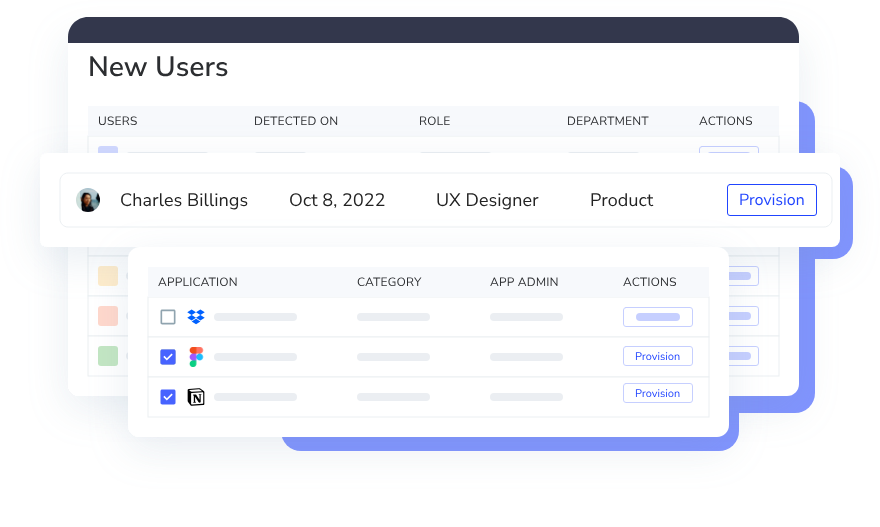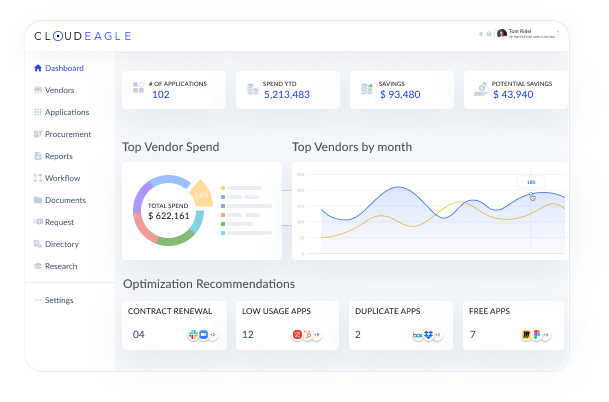In the era of cloud-based products, successful companies recognize that efficient SaaS user management is essential for productivity and efficiency.
Disregarding its significance could prove costly, impacting financial prudence, data security, and compliance efforts. Efficiently managing app users is crucial for IT, finance, and procurement teams aiming to optimize their SaaS stack and achieve maximum benefits.
By gaining accurate insights into user controls, permission levels, and application access, IT teams can optimize resource allocation, boost productivity, and proactively minimize potential security and compliance risks.
In this blog, we'll explore the intricacies of SaaS user account management, best practices, and the many benefits of powering your business with efficient SaaS user management.
What Is SaaS User Management?
SaaS User Management is the process of effectively monitoring and managing user accounts and user access to applications. It enables IT and finance teams to ensure that individuals have the right access permission levels and privileges based on their roles and responsibilities.
Here are the requisites for effective user management:
- Number of applications in the stack
- Details of users in the organization
- Active user accounts
- Access, and permission levels of each user
- Number of provisioned users for each application
- Centralized user management dashboard
- Automated workflows for repetitive tasks
- Instant alerts to prevent unauthorized access
This list shows that user management is not a task to be done manually. Organizations need a robust SaaS user management platform to centralize users and applications, automatically provision and deprovision users, and send alerts.
Through effective SaaS user account management, businesses can gain better control, safety, and cost-efficiency in their SaaS ecosystem, guaranteeing seamless operations and optimized results.
Why Is SaaS User Management Necessary?
Prevents unauthorized access and keeps the stack secure
Hacker News states, “84% of the companies had employees using an average of 3.5 SaaS applications that were breached in the three months.”
Effective user management acts as an essential defense against unauthorized access to sensitive information and apps.
With strict access controls, it guarantees that only authorized employees can access specific SaaS products. This is a strong safeguard against cyberattacks on sensitive data, and prevention of data breaches.

Easy provisioning and deprovisioning of SaaS users
With a streamlined SaaS user management procedure, IT leaders can smoothly provision new users with access to essential apps. This simplifies SaaS user onboarding for new employees, enabling them to get started right away.
Through HRIS integration, the entire provisioning process can be automated using rules. And whenever a new employee joins, the platform will automatically recommend apps based on employee’s department and job title.
Additionally, efficient user deprovisioning ensures that access to SaaS products is immediately withdrawn when employees exit, reducing the security concerns associated with lingering accounts.
Streamlines user access controls and permissions
SaaS user account management gives IT leaders control over each app's user access and permissions based on an employee's job function.
This improves security and enhances productivity by giving workers the tools to complete their work efficiently while restricting unauthorized privileges.
SaaS User Management Best Practices To Follow In 2023
1. Evaluate the SaaS tools you use
Gartner found that 25% of a company’s SaaS tools are unused or underused.
Do routine audits of your company's SaaS stack to determine the applications being used, what they are used for, and how many people use them. To cut costs and streamline the software ecosystem, evaluate the value that each tool provides your business and eliminate unused or redundant apps
2. License management
Possessing complete control over users and their access to applications makes it easier to provision app licenses. Analyze the usage data, reallocate the licenses to those who need them, eliminate unused licenses, and save on software spend. But this is only possible if you manage your users effectively, or you might end up eliminating licenses that are still required.
A platform like CloudEagle has automated workflows for license reallocation. When the platform identifies that the license is not being used, it’ll automatically deprovision the user and harness the license. Then the license can be provisioned to the user in need.
3. Monitor software usage
Utilize SaaS Management Platforms (SMPs) to monitor and evaluate how employees use various apps. Get information about application usage habits, user activity, and adoption rates. Knowing how apps are utilized within the business allows you to correctly allocate resources and ensure that SaaS tools correspond with business goals and user preferences.
4. Automate workflows
Identify possibilities to automate user provisioning and other time-consuming tasks within your business workflows.

Use automation solutions to improve efficiency, decrease manual errors, and streamline procedures. By automating regular processes, your team can focus on strategic goals and productivity.s.
5. Monitor app purchases
Organizations are tackling shadow IT or shadow purchases as we speak. Reports show that shadow IT accounts for 30–40% of IT spending. Monitor purchasing behavior, and automate alerts using a SaaS management platform for when a user purchases an unsanctioned application.
6. Implement MFA
Educate your users and enforce Multi-Factor Authentication (MFA) for all user accounts. This adds an extra layer of security and protects sensitive data from unauthorized access. Also, implement SSO providers for efficient SaaS user onboarding and offboarding procedures from a centralized location.
7. Leverage a SaaS management platform
We repeat, none of these best practices can be implemented if you don’t invest in a SaaS management platform. It can integrate with SSO and HRIS systems to centralize all the users and access controls.

You can automate SaaS provisioning and deprovisioning, streamline SaaS user onboarding with Role-based access controls, and get the maximum value out of SaaS applications.
Managing SaaS users with a SaaS management platform
A SaaS management platform has advanced features that aid in efficient SaaS user account management. Organizations can leverage these features to secure their SaaS stack, limit user access, and boost productivity. Here are a few significant characteristics and advantages:
Centralized User Directory: Users and their access to various applications and permission levels can be managed from one centralized location.
License Tracking: Identifies purchased licenses and enables you to provision them to the right users. You can harness licenses with low usage and re-allocate them to other users based on the requirements, or you can eliminate them to save on SaaS spend.
Usage Monitoring: Analyze app usage data and question users on why their app usage is low; this will help you gauge the requirements and allocate the budget accordingly.
RBAC (Role-Based Access Control): Auto-provisioning rules are available to automatically suggest the right apps to users based on their roles and departments. You don’t have to visit each application to provision them, grant access, or revoke access from one place.
What are the Benefits of a SaaS user management solution?
- Real-time Updates: Allows instant updates across systems and software, minimizing errors and increasing data accuracy.
- SaaS System of Record: Provides a centralized source of truth for business divisions, fostering collaboration and data consistency.
- Finance Optimization: Aids in budget management by offering information on software subscriptions and costs.
- Efficient Access Control: The IT/ HR team can manage employee access to the appropriate tools, improving security and efficiency. Thereby easing SaaS user onboarding and de-boarding.
- Secure Authentication: Assists IT in enforcing stringent access control and identity authentication processes for data security.
- Enhanced Leadership: Allows leaders to gain access to the apps they need to fulfill team goals and increase overall performance.
CloudEagle for SaaS user management
CloudEagle, with all of the above features, is one of the most robust SaaS management platforms around. The solution has a vast integration library to provide complete visibility into apps and users.
Are you using individual applications to manage apps, users, spend, and procurement? Well, it's time to consolidate all those use cases into one solution, CloudEagle.
From centralized user account management to usage tracking and RBAC-based user provisioning, CloudEagle has all the features to manage your users effectively and keep your SaaS stack secure from unauthorized users and security breaches.
Are you ready to improve your SaaS user management and increase productivity? Book a demo today!
Frequently asked questions
1. What are the methods of user management?
In SaaS, user management entails a variety of methods for efficiently managing user accounts and access. The following are the primary methods:
- User Provisioning: This method is concerned with the creation, modification, and deletion of user accounts, ensuring a smooth onboarding and offboarding experience.
- SSO (Single Sign-On): SSO enables users to access various apps with just one set of login credentials, improving ease and security.
- MFA: It adds an additional degree of security by asking users to present multiple forms of identification for authentication.
- User Role Management: It optimizes data security and access control by assigning precise permissions and access privileges depending on user roles.
- User Activity Monitoring: This method monitors and records user actions and engagement inside the system in order to increase accountability and identify suspicious conduct.
- Password Management: It enforces good password practices via policies and tools, improving data security against unauthorized access.
- Access Control Lists (ACLs): ACLs maintain and enforce user permissions for files, directories, or resources at a granular level, ensuring accurate access control.
2. What are the different types of access controls?
Most common access controls in SaaS user management include;
- Role-Based Access Control (RBAC): Assigns people distinct roles based on their responsibilities and grants access rights accordingly.
- Attribute-Based Access Control (ABAC): Makes access decisions based on numerous criteria such as user traits, environmental circumstances, and data classifications.
- Policy-Based Access Control (PBAC): enforces access control via explicitly set permissions for specific users, allowing for fine-grained regulation of data access and actions.
- Mandatory Access Control (MAC) imposes rigorous access controls defined by system administrators, restricting user discretion over data access.
- Multi-Factor Authentication (MFA): It offers an additional layer of protection by requiring users to provide several means of identity to access the SaaS platform, such as a password, fingerprint, or one-time PIN.
%201.svg)
%201.svg)


.png)
.png)
